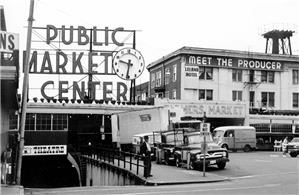On November 2, 1971, Seattle voters approve Initiative No. 1, which establishes a seven-acre historic district "to preserve, improve, and restore the Pike Place [Market] ... prohibiting alterations, demolition, construction," or other modifications without approval of a 12-member commission. The measure passes by a vote of 76,369 to 53,264, a three-to-two majority, and ends an eight-year controversy over the fate of the Market.
The campaign was the culmination of more than eight years of controversy over the efforts of the Central Association (later the Downtown Seattle Association) to replace the Market with offices, hotels, and parking garages. The City of Seattle had adopted a scaled-back urban renewal plan that preserved a 1.7-acre "core" Market.
Preservationists led by architect and University of Washington faculty member Victor Steinbrueck (1911-1985) organized the advocacy group Friends of the Market and collected signatures for Initiative No. 1 to create a seven-acre preservation zone. A second group, the Alliance for a Living Market joined the Friends. The Central Association, representing downtown businesses, started the Committee to Save the Market, with the support of Market tenants like Reid Lowell and Pete De Laurenti, to oppose the initiative.
The controversy ended when Seattle voters sided with preservationists and voted to save the entire seven-acre Market historic district.

